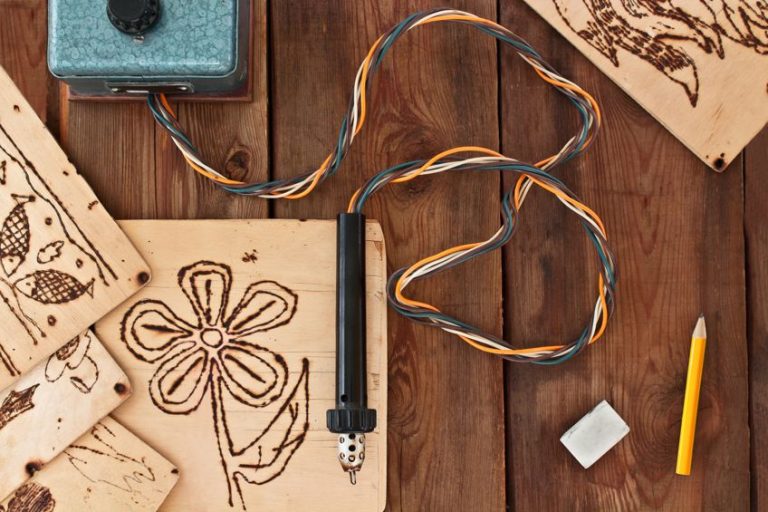What Is a Mandala? – Learning About the Meaning of a Mandala
What is a mandala? This might be a question asked in more Western cultures, where a mandala is not as common. On the other hand, Asian art portrays the mandala in detail because it is more prevalent in these cultures. In this article, we will be showing you more of the mandala meaning and helping you to understand the different types of mandalas and their meanings.
Table of Contents
- 1 Definition of a Mandala
- 2 Brief History of Mandalas
- 3 What Is the Purpose of a Mandala?
- 4 Cultural and Historical Significance of Mandala
- 5 Mandala Symbolism
- 6 Types of Mandalas and Their Meanings
- 7 How to Create Your Own Mandala?
- 8 Benefits of Creating a Mandala
- 9 Mandalas and Chakras
- 10 Frequently Asked Questions
Definition of a Mandala
The word “Mandala” is a Sanskrit term that when translated means “circle”, “center’ or “discord object”. The geometric design of a mandala can be constructed or fashioned on cloth, or paper, drawn on different surfaces using threads, built in stone, fashioned in bronze, paintings, or 3-D models. What is a mandala?
A mandala can be described as a circle or geometric design, that is controlled, or enclosed within a square, and arranged in sections that are structured around one central point.
The repeated shapes, colors, or patterns may be carefully measured and precise, and perfectly symmetrical, or they can be asymmetrical or free-flowing. In Buddhist and Hindu cultures, a mandala embraces a lot of symbolism and represents various aspects of Buddhist teachings. It is also an instrument used for prayer mostly in Japan, Tibet, and China.
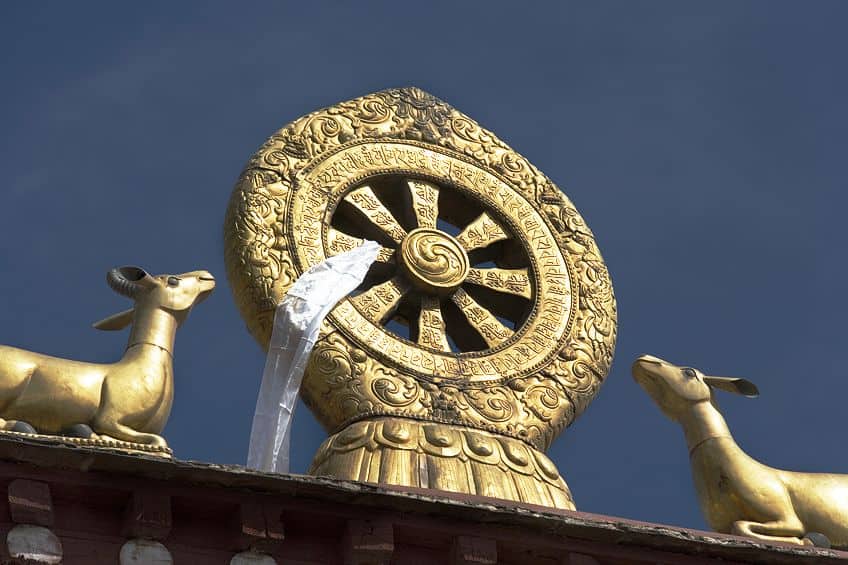
A mandala is a very complex representation of different aspects of our universe and constitutes an instrument used for developing great qualities that will be of benefit to others. Entering a mandala, the belief is that as you start on the outside and proceed to the center, you will be guided through a cosmic process that will transform the universe from suffering and pain to one of joy, peace, and happiness.
However, the true meaning of a mandala depends on the individual, the creation or observation of that image that centers around the awareness of your place or purpose in the world through meditation.
Brief History of Mandalas
The founder of Buddhism, Siddhartha Gautama, was born in Nepal somewhere around 560 B.C. It is understood that he decided to leave his kingdom when he became aware of all the human suffering around him. So, he began to seek enlightenment through thoughtful action and meditation. He started to preach his philosophy across India and gained followers, enabling him to start his first Buddhist community for monks.
These Buddhist monks began to travel the Silk Road, which is a network of trade routes that linked the West to the East, bringing the Buddhist philosophy to other countries.

By the fourth century, these Buddhist monks would carry mandalas with them, spreading the mandala practice of painting some of these spiritual concepts, to other regions in Asia, like Tibet, Japan, and China. Although the history of mandalas had its roots in Buddhism, it soon began to appear in Hinduism and many more religious practices.
What Is the Purpose of a Mandala?
Ever since their creation, mandalas were used as symbols for meditation, concentration, protection, a personal maturity process, and healing. Different religions, philosophies, and cultures, all use different techniques of mediation when using mandalas.
Using a mandala can help you to find yourself, or the path you wish to travel.
Spending time cultivating harmony and peace within your heart. From this, you can find gentle words and thoughts that can show you new paths or directions. If you are passionate about coloring and want to try something different, try to color a mandala and find the purpose of a mandala for yourself. Have a look at the benefits of coloring a mandala.
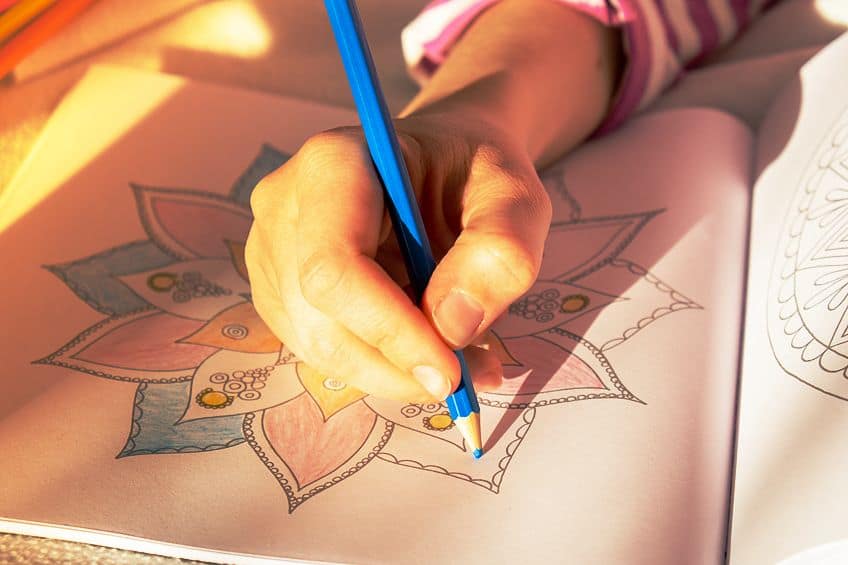
- Self-expression
- A sense of connection
- Improve concentration
- Increase relaxation
- Relieve stress
- Foster mindfulness
- Alleviate insomnia
- Decrease anxiety and depression
- Strengthen brain function
- Lower blood pressure
Cultural and Historical Significance of Mandala
Mandalas originate from the Hindu and Buddhist traditions. They are seen as objects for meditation and assisting in one’s spiritual development. The mandala image portrays the universe, and all the symbols represent your spiritual journey, from birth through life to death, interconnecting all living things. Let us now consider some of the cultural significance of the mandala.
Mandala in Buddhism
In Buddhism, the mandala represents the universe and emphasizes the potential of enlightenment. The mandala can be made on a wall like a scroll painting, or just an ordinary painting, and can also be made on any table using some colored sand. The pictures shown in the mandala illustrate any obstacles that need to be overcome to be able to cultivate wisdom and compassion.
The Buddhists use their mandalas for meditation purposes and make an imaginary palace, allowing them to focus during their meditation, and each object has a significant meaning.
The objects can represent any aspect of their Buddhist wisdom, or else remind them of anything concerning guiding principles. The mandala’s sole purpose is to transform their ordinary mind into one that is enlightened and to assist in healing their minds. Many of the Buddhist mandalas contain certain deities right in the center, which represent the views of their religion and serve as role models.

In the Vajrayana Buddhist religion, many of the mandalas are made into sand paintings and show the nature of an enlightened and pure mind. The Buddhist mandalas also represent the complete universe and can serve as a diagram for Tibetan cosmology. Some of the Buddhist mandalas act as symbols of impermanence and wisdom and represent the transient nature of life, making us mindful of death.
Other forms of Buddhist mandalas speak of the various aspects of enlightenment.
Mandala in Hinduism
The Hindu mandala is in the form of a square that has four T-Shaped gates. Each gate opens toward the center, this configuration is referred to as “Yantra” and is smaller than the traditional mandala and only consists of two colors. The Yantra mandala can be either two or three-dimensional and is mainly used in pujas or sadhanas. The geometric design of these mandalas may also incorporate another mandala, which would represent the home of one of the deities that they worship.
The unique design and construction of yantras used in pujas are regarded, by Hindu scholars, as spiritual aspects, and cosmic truths of human life.
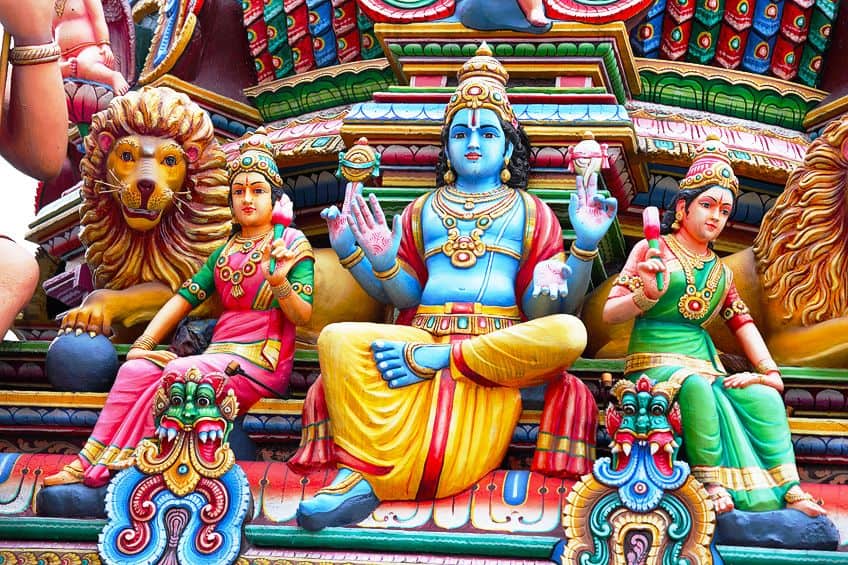
The Hindu mandala and yantras, according to certain yogis, do not only simply represent deities but they are a reality. The Hindus firmly believe that there is a definite connection between the universe or outer world, and man’s inner world, and the mandalas resonate this connection. The images and symbols of the mandala have a profound spiritual significance and represent the spiritual journey of the human life cycle of birth, life, and death. These images and symbols also represent the connection there is between living beings with the merging of self with the divine universe.
Mandala in Native American Culture
In the Native American Culture, mandalas are a powerful symbol and are regarded with extreme respect. The various tribes use them during ceremonial blessings, prayer, traditional rituals, and vision quests. Those who appreciate and connect with the mandala understand that their thoughts and desires often hide the deeper messages in their lives. Mandalas can be used to uncover or unmask their true destinies and feelings, as they represent the true diversity within the earth.
When you dream big, then sometimes you start to doubt yourself and begin to question things like where to start or where are the resources going to come from.
By focusing on your fears, you become so overwhelmed with difficulties that you fail to take any productive action to make your dreams a reality. Mandalas can be used to assist you in not setting any limits to your vision or dreams, remember anything is possible if you are prepared and willing to make things happen. So, once you have your dream, set a realistic plan, follow its progress, and make any necessary changes, always trying to keep your vision or dreams on track. Here are some of the Native American Mandala Symbols for you to follow.
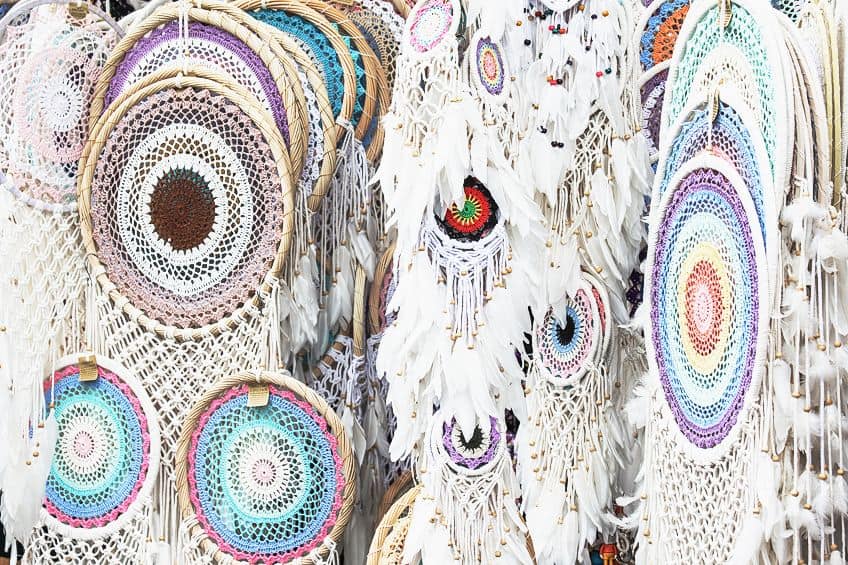
- The dream catcher: This is the most popular of all the Native American Mandala Symbols and was not only used by the various tribes but has also become a symbol used, and believed in, by many today.
- The feather: The feather is another common mandala symbol and represents spiritual and mental strength. This is why the chief would wear feathers as headgear, symbolizing his wisdom and also as a sacred communication with the spirits.
- The labyrinth: The labyrinth, or maze, helps us to understand our journey through life, but also has a hidden and deeper meaning, as it provokes us to think of the philosophical questions in our lives, which means it has a physical as well as a spiritual symbolism.
- Sun and wind: The sun and the wind were recognized by the Native American culture as the elements that affected their lives daily, the sun representing life and the wind representing the guiding spirits.
Many use the mandala as a tool to give direction to their lives, providing an understanding of our life’s journey as we connect with nature and the universe. Focusing and relaxing on these symbols allows our minds to block out unimportant things and delve deeper within ourselves.
Mandala in Psychology Today
Mandalas are recognized by people in the psychology field as therapeutic. Carl Jung, a Swiss psychologist, believes that mandalas are representations of our minds, as they enable us to concentrate and transform unconscious things in our minds. We then project what we feel and think into mandalas. Many different branches of psychology see the benefits of mandalas in different ways.
Transpersonal psychology believes mandalas provide an exercise for deep connection, while behavioral psychology sees it as a tool to improve one’s attention, memory, visual motor skill coordination, and perception.

There are also other ways that people use mandalas, like occupational therapy where cognitive stimulation assists in people’s daily lives. In educational fields, mandalas help to increase attention, concentration, and discipline. There are many other psychological ways that mandalas can benefit all of us, they serve as pieces of art that can assist in helping us to free our minds and relax. Mandalas can offer you huge creative potential, so why not give them an opportunity?
Mandala Symbolism
There are intricate patterns involved in all mandalas, most of the common patterns are represented by a wheel, flower, tree, or jewel. At the center of the pattern, there is a dot which symbolizes a space free of dimensions and is the starting point of the pattern. From there the dot is encircled by lines that create a geometrical pattern symbolizing the universe. Below are certain examples of mandala symbolism.
Circle Symbolism
The word “Mandala” literally means a circle which also has circles within the circle, symbolizing focus, and attention. This type of mandala can assist you in meditation and focus and help in developing better concentration. The Celtic five-fold symbol has four circles and then a fifth circle linking them in the center.
This can symbolize the direction north, south, east, and west, or the elements fire, water, air, earth, and ether, or it can represent the four seasons with the fifth circle representing the passage.

The mandala patterns symbolize the drawing of the person in, and they then sense themselves within the mandala. This is a normal reaction for circles anywhere, drawing the viewer to include themselves within the design. Circles also symbolize wholeness, oneness, and unity, and circles in the mandala can indicate a new beginning or the completion of any task.
Circle Mandala in Art and Jewelry
Circle mandalas are available in almost any color, with an unlimited number of patterns. It is extremely flexible lending itself to amazing artistic expression. There are paintings, prints, or drawings available, and are even seen in collages, sculptures as well as fiber arts. The mandala circle patterns lend themselves extremely well to any form of jewelry.
There are delicate circle mandala earrings, pendants, broaches, and tons more.
Circle Mandala Coloring Pages
Coloring mandala circles can be extremely relaxing, therapeutic, and loads of fun. You can even create your own mandala circle patterns by using a pencil and a compass, circles of different sizes, circles within circles, or even circles joining circles. For coloring your mandala’s circle patterns, you can use colored pencils, watercolors, pastels, crayons, or even charcoal.
Circle Mandala Tattoos
Mandala circle patterns make amazing tattoos. You can make them complicated, keep them simple, or be full of color. Also, your design can incorporate other mandala symbols, giving each tattoo a special meaning and symbolism. Mandala circle tattoos can be placed on a flat part of your body, or wrapped around your leg or arm, but it is best if the whole pattern can be viewed all in one glance.

Geometric Shapes and Symbols
The geometric shapes and symbols of the mandala represent the earth, the underworld, and the cosmos, and are used for spiritual exercises such as meditation regarding the nature of creation and life. These mandala geometric shapes start at the center, or origin, and then move outward, and are regarded as sacred geometry that attracts and releases positive energy.
These geometric mandalas come in different forms, and here are some of the basic shapes and their meanings.

- The circle: The circle starts at the center and leads outward, representing the cosmos, harmony, energy, soul, and concentration.
- The triangle: The triangle is a symbol of vitality, transformation, and higher harmony, and is often the basis for configurations and sacred buildings.
- The square: The square symbolizes the temple and represents the seat of the deity.
- The star: This shape is a representation of freedom and the clergy.
- The heart: The heart symbolizes love, union, solar warmth, and happiness.
- The flower: The flower symbolizes transience, beauty, and soul.
- The triangle upside down: This shape or form of mandala symbolizes unconsciousness and femininity.
- The triangle facing up: This shape represents creativity and masculinity.
- The triangle pointing towards the center: This shape is effective against aggression that is targeted against oneself.
- The cross: The cross serves as a connection between life and death, as well as earth and heaven.
- The wheel: The wheel is a force of vigor.
- The rainbow: The rainbow serves as a form of ribbon between people.
Colors and Their Meaning
Colors all have different meanings and functions in culture, religion as well as art. If you know and can choose the right color for your mandala, you will be able to show the real and true meaning of each symbol that you have in your mandala. Here are the mandala colors and their meaning in psychology, the meaning of colors in other religions and cultures may differ slightly.
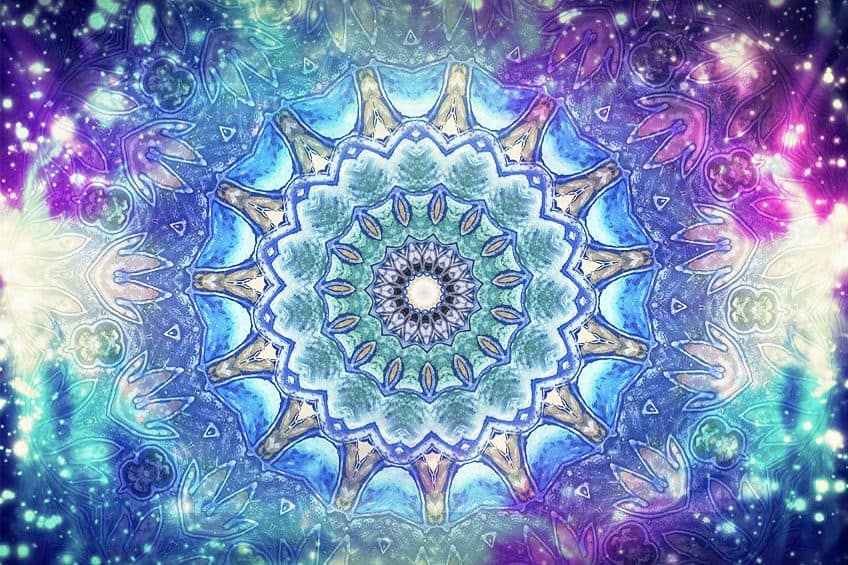
- Black: This is the mandala color that symbolizes deep thinking, mystery, and individuality.
- White: When looking at this mandala color, it symbolizes purity and spirituality.
- Red: The mandala color that symbolizes high energy, passion, and strength.
- Orange: This is the mandala color that symbolizes intuition, transformation, creativity, and self-awareness.
- Yellow: A mandala color that symbolizes happiness, learning, wisdom, and joy.
- Green: This particular hue symbolizes greenery, care, love of nature, improving physical condition, and mental ability.
- Blue: The color that symbolizes meditation and emotional healing.
- Purple: A mandala color that symbolizes everything spiritual.
- Pink: This mandala color symbolizes love and intuition.
Types of Mandalas and Their Meanings
Many different types of mandalas have originated from various cultures and have been used for a variety of purposes. So, what are mandalas used for? Let us now consider four of these different types of mandalas and their meanings.
Sand Mandala
The sand mandala originates from the ancient Tibetan Buddhist tradition that involves various ritual geometric patterns that are created from colored sand. The creation of a sand mandala can involve multiple people, normally it involves four monks that each start to work on a side of the mandala. During the sand mandalas creation, a great deal of positive energy is released, and concentration is always in one spot.
While the four monks are busy creating the sand mandala, other monks are busy praying and chanting mantras, as they call upon their deity. This releases positive energy that will fill the environment.
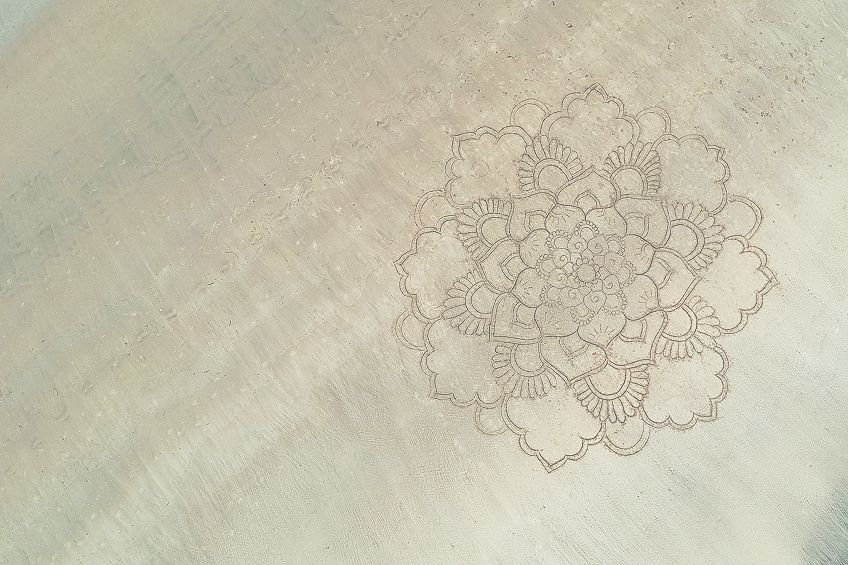
This is evident in the Chenrezig mandala, which is the Buddha of compassion, so it will generate a great deal of compassionate energy. Some of the sand mandalas can be very complicated like the Kalachakra mandala which contains 722 deities within the mandala. Other smaller mandalas contain fewer deities with less geometry but may still take weeks to complete.
Thangka Mandala
A thangka mandala is a painting depicting a Buddhist Mandala or some type of deity, that consists of pictures that are painted on a cotton cloth and mounted on a silk frame. It is a very delicate painting but can last for a long time, always retaining its luster. These thangka mandalas paintings serve as important meditating and teaching tools. Most of the original thangka mandala paintings portray different influential lamas, the life of Buddha, or some relevant deity.
The most prolific theme portrayed as you enter a Buddhist monastery is “The Wheel of Life”, which is an illustration showing the Abhidharma traditions that is the key concept of the Buddhist doctrine.

The thangka mandala painting can be regarded as an object of decoration, but for Buddhist monks, it is of important spiritual significance and is revered by them. They believe it contains mystic powers according to the deity it represents. It is often used in ceremonies and rituals as a medium for prayers, and meditation helps to bring them further down the pathway to enlightenment.
Yantra Mandala
A yantra, or Tantric Buddhism, is an elaborate linear diagram, which in its pictorial format is known as a mandala. and is often used by Hindus and Buddhists in meditation practices. The word” Yantra” is derived from the Sanskrit root and can mean, “Instrument, prop, tool, or support”, but can also mean “Something that controls, keeps or retains”, and is often worn as an Amulet. Initially, the yantra was used to encode the sacred knowledge of the cosmic laws of the universe and represented aspects of energy found in planets, deities, and chakras.
This knowledge was used as a blueprint for building their temples.
It is now also worn as an amulet, which is believed to attract wealth, gain love, and protect from their enemies. The main purpose, or aim, of the yantra is to get your mind focused, which will then allow you to connect to energy stored in the yantra. This will help you to increase awareness, self-realization, and harmony. It is believed that yantras have the power to influence your energy, body, and consciousness.

Yantras are normally created using geometric figures, which can be very complex containing numerous geometric forms and numerals. It can also be simple like a cross, a circle, a triangle, or a heart, among others. Most yantras are monochrome, purely geometric, and decoration free, unlike the mandalas that have flora and fauna and images of deities and are very decorative. Normally the yantra is carved onto metal, wood, or stone and used in building their temples, but can also be painted on silk to preserve the energy and can also be painted or drawn on paper.
It is also thought that the human body is regarded as a yantra.
The Medicine Wheel
The medicine wheel, also known as the “sacred hoop”, forms part of various Native American tribes. It has been a source of healing for many generations. It represents the four directions, north, south, east, and west, but also includes the mother Earth, farther sky, and spirit tree, which all symbolize the cycles of life and health. The medicine wheel takes many different forms, it can be an artifact, artwork, a painting, or a physical structure that is on the land. Many of these physical structures have been built over the years mainly by the North American tribes and used in certain ceremonies.
The structure is built in a circular form with four sections, indicating the four directions, with a fifth direction pointing down into the earth, and a sixth direction pointing up toward the sky.
Movement within the wheel is made in a clockwise direction, aligning the forces of nature like the rising and setting of the sun, and the force of gravity. The four directions each have a significant meaning, east represents psychological, south represents physical, west represents social, and north represents spiritual. It helps the individual to overcome certain deficiencies like self-denial, self-discipline, and other conflicts.

Apart from the religious ceremonies of the ancient tribes in the past, today, the medicine wheel symbolizes various teachings, philosophies, and beliefs, and is regarded as a symbol of wholeness by psychologists and is used as an introspection tool. Apart from its healing properties, the medicine wheel is also used in jewelry design showing the four quadrants in different colors, some have gemstones, bones, feathers, seashells, and other items added each with their symbolism.
How to Create Your Own Mandala?
When creating your mandala, you need to look inside yourself, and then find some shapes, patterns, or colors that will represent anything of your current state of mind or some deep desire that you have for yourself or a loved one. Drawing and then coloring mandalas can be a very inspirational as well as personal experience.
Mandalas can be great tools for you to use for meditation as well as increasing self-awareness.
Being able to design your own mandala means that you can choose your own colors and shapes. Remember, this is your mandala, and you are free to create and draw anything unique to yourself. The following is a guide to help you in your quest.
Materials Needed
There is no special material that you need, and to make it more acceptable to everyone, in this tutorial, there is no need for a compass, but if you have one, feel free to use it. Find what you will need to draw and color your mandala below.
- Paper
- Ruler
- Pencil
- Eraser
- Compass
- Colored pencils
- Watercolors
- Markers
- Crayons
- Gel pens
Steps to Follow
You may have noticed that for the coloring of your mandala, we have included a list of different mediums. There is no need for you to purchase all of them, it is up to you to decide what medium you want to use for the coloring-in process.
Step One
The first thing you need to do is to find a piece of paper and ensure you measure it so that it forms a square. It can be any size square, the larger the square the more space you will have to insert any details. However, a normal size square is about 8 x 8 inches. Now take your ruler and pencil and mark out a dot right in the center of the square.

Step Two
The next step is to draw several circles around the dot. The easiest way to draw a circle is to use a compass, but if you do not have a compass do not worry, follow these steps instead. Take your ruler and put it onto the dot, then measure about 1/2 an inch from the center up above the dot, down below the dot, to the left of the dot, and finally to the right of the dot.
Step Three
Take your ruler and measure another dot, this time one inch from the dot in the center of your square. Follow the same process, up, down, to the left, and right. Then you can make as many rows of dots as you want, making sure all of them are equally distant from the center of your square.
Step Four
Next, take your ruler and draw a line connecting the dots, a vertical line connecting the dots up and down, and a horizontal line connecting the dots to the right and left. This should be an equal distance on both sides of the vertical line.

Step Five
Draw another series of dots that are also the same distance from the center, like the first set of dots. However, this time they need to be at a 45 degrees angle from the vertical and horizontal lines, in both directions. Do not be too concerned that they are all perfect, the whole idea is to draw your mandala and have some fun.
Step Six
Take your ruler and pencil and connect the dots you have just made; you should now have four lines going through the center. Now connect all the dots using a curved line forming your circle, again do not be too concerned if it is not a perfect circle. Draw the lines softly so you can erase any mistakes.
Step Seven
It is now time to begin to outline your mandala design. You can start by drawing small petal-shaped designs in the center of the circle. It is a good idea to first use colored pencils to draw your design.

Step Eight
By using the circles and lines you drew as a guide, start by adding any shape you want, circles, triangles, loops, or raindrops. You need to repeat the shapes in the right places. If you draw a shape on one line, make sure you repeat this on the other lines. This repetition is the key element for creating your mandala.
Step Nine
You can draw as many shapes as you like, and your mandala should begin to look slightly more complex. The key to this process is to take your time and draw one shape at a time repeating the same shape in the right place all around the circle.
Step Ten
You are almost done. It is time to start to color your mandala, you can choose to use only one color, or you can use as many colors as you like. You may even decide to leave your mandala as it is without coloring it at all, the final decision is up to you. Your mandala is now complete.
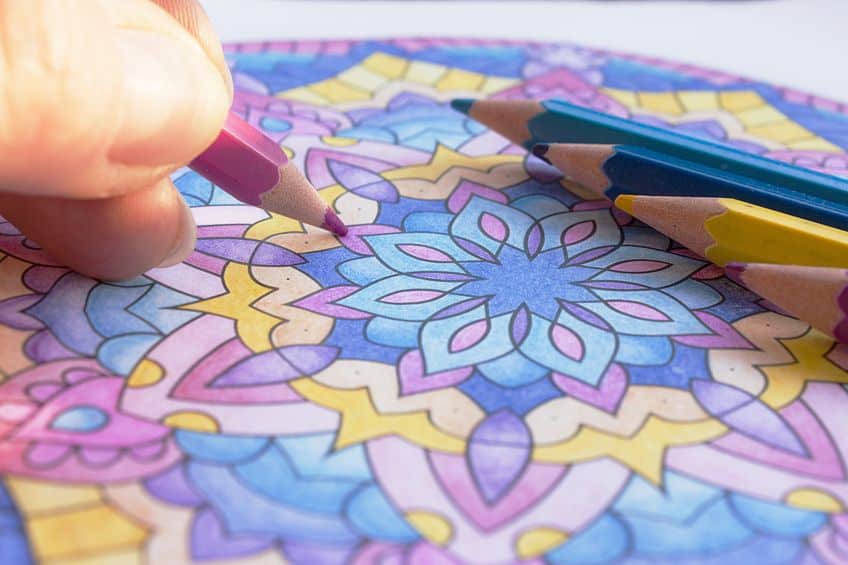
Benefits of Creating a Mandala
Creating and coloring a mandala is a wonderful experience as it can soothe your mind as well as create a sense of balance. As you add color to your mandala, it causes your brain waves to slow down as the repetitive process acts as a protective frame, which helps your brain to move into an alpha wave state that can bring calm and balance.
Personal Growth and Mandala Art Therapy
Creating a mandala allows you to explore many different colors, patterns, and shapes. The process is very therapeutic, and once you start, you will become hooked. Drawing and coloring a mandala is a great way of relieving stress and allows you to unwind. Mandala art therapy is beneficial as it allows you to consciously work through your feelings, emotions, and thoughts, without any external pressures.
They also reflect certain aspects of your personality, enabling you to explore your emotions and feelings and then develop your creative style.

Where there are serious mental health issues, creating a mandala can help you to cope. If this is the first time you are creating a mandala, and you do not know how or where to start, then just follow the step-by-step tutorial above, or print out a pattern that suits you from the web and spend time coloring it in.
Helps With Stress Relief
Mandalas offer you repetition, symmetry, and balance, and although drawing a mandala may seem to be a challenge, coloring one in requires a lot of concentration and can be a way to find peace and de-stress. Apart from helping you to relieve your stress, a mandala can also help to reduce any anxiety you may have, and at the same time reduce your heart rate.
Very similar to a warm blanket on a cold night, you will soon discover that you are drawn back to your comfortable mental space, repeatedly.
Spiritual Development
Creating and coloring a mandala is a great way for you to cultivate your spirituality. When coloring, you need to keep your mind focused on what you want to achieve. During this process, you may experience a sense of peace as the process of spiritual development requires visualization and a connection to your highest possible self. To fully comprehend the process, you must first understand what a mandala is.
Meditation
Mandalas can have multiple geometric patterns, and by creating and coloring them, you can relax your thoughts and reach a state of meditation. This type of meditation has been shown to improve health and relieve stress. Many people who have used this form of meditation have reported that they found the process thought-provoking as well as enjoyable, making it a fun exercise to participate in. The beauty of a mandala is that there is no right or only way to color in, but the colors and shapes are all symbolic of your own circumstances.
So, however, you may choose to color a mandala, it is an expression of your own goals, feelings, principles, and values.
Mandalas and Chakras
Chakras are energy points or centers in your body, and their purpose is to regulate all the processes in the body, starting with organ function to emotions and the immune system. Seven chakras are situated throughout your body, starting at the base of the spine and moving up to the top of the head. Each chakra has its own color and frequency that governs specific functions in your body making you well and whole.
These energies help to keep you emotionally, psychologically, spiritually, and physically balanced.
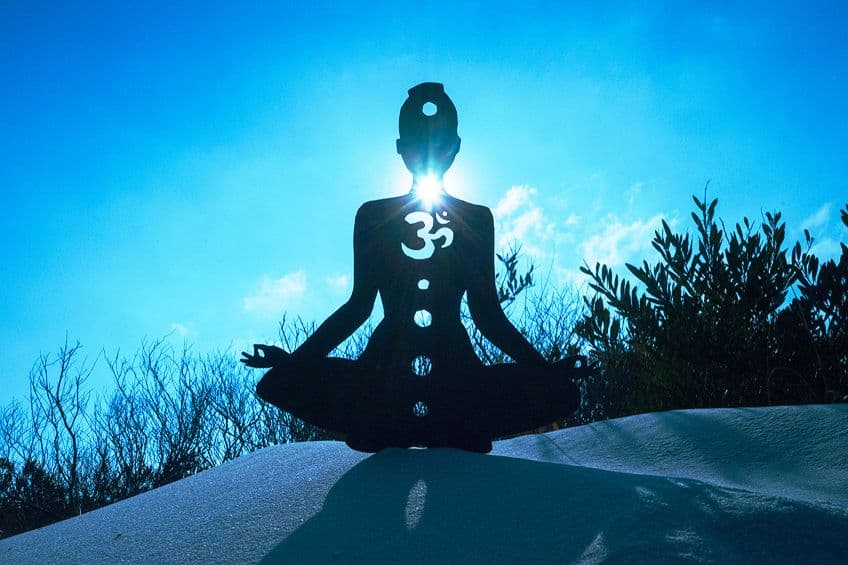
If you are experiencing trouble emotionally, physically, spiritually, or mentally, then your chakras may be out of balance. How do we then balance our chakra system? Mandalas are the answer, as you draw and color your mandala the energy contained within the mandala interacts with your chakra system helping to harmonize these aspects. Through the drawing and coloring of your mandala, you can align these energies, balance your emotions, and make yourself more relaxed and at peace within yourself.
Irrespective of the different cultures and religions in the world today, mandalas appear in one or another form in almost all of them. The geometric forms and designs can be seen in dream catchers, meditative practices, and healing circles. The creation and coloring of mandalas is a transforming process that helps to restore your inner peace.
Take a look at our mandala definition webstory here!
Frequently Asked Questions
What Is the Purpose of a Mandala?
The Hindus and Buddhists used the mandala diagrams to perform sacred rituals and ceremonies, and it is also an instrument used for meditation. The mandala diagrams represent the universe that serves as a focal point to combine universal forces.
What Are Mandalas Used For?
Mandalas are used mainly for meditation, protection, concentration, personal maturity, and meditation. Various techniques are applied when meditating with a mandala, as there are so many different types of cultures, religions, philosophies, and artistic contexts.
What Is the Meaning of Mandala?
A mandala’s meaning takes its roots from Sanskrit and means “circle”, and although there are other shapes within the mandala, like triangles and squares, the mandala always has a circular or concentric nature. The mandala meaning largely depends on the colors used, the culture, and the geometric elements.
In 2005, Charlene completed her Wellness Diplomas in Therapeutic Aromatherapy and Reflexology from the International School of Reflexology and Meridian Therapy. She worked for a company offering corporate wellness programs for a couple of years, before opening up her own therapy practice. It was in 2015 that a friend, who was a digital marketer, asked her to join her company as a content creator, and this is where she found her excitement for writing.
Since joining the content writing world, she has gained a lot of experience over the years writing on a diverse selection of topics, from beauty, health, wellness, travel, and more. Due to various circumstances, she had to close her therapy practice and is now a full-time freelance writer. Being a creative person, she could not pass up the opportunity to contribute to the Art in Context team, where is was in her element, writing about a variety of art and craft topics. Contributing articles for over three years now, her knowledge in this area has grown, and she has gotten to explore her creativity and improve her research and writing skills.
Charlene Lewis has been working for artincontext.org since the relaunch in 2020. She is an experienced writer and mainly focuses on the topics of color theory, painting and drawing.
Learn more about Charlene Lewis and the Art in Context Team.
Cite this Article
Charlene, Lewis, “What Is a Mandala? – Learning About the Meaning of a Mandala.” Art in Context. May 31, 2023. URL: https://artincontext.org/what-is-a-mandala/
Lewis, C. (2023, 31 May). What Is a Mandala? – Learning About the Meaning of a Mandala. Art in Context. https://artincontext.org/what-is-a-mandala/
Lewis, Charlene. “What Is a Mandala? – Learning About the Meaning of a Mandala.” Art in Context, May 31, 2023. https://artincontext.org/what-is-a-mandala/.






